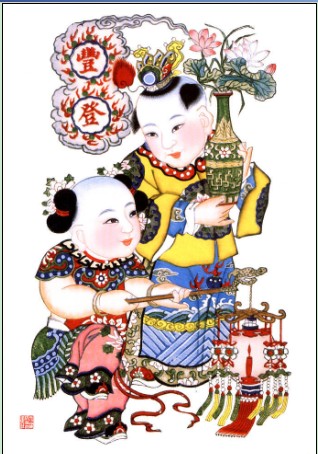Yangliuqing New Year’s painting

nipic.com
Yangliuqing New Year's painting
A traditional folk painting for Lunar New Year in Northern China, the Yangliuqing wood-engraved paintings take their namesake from their place of origin, Yangliuqing County in Tianjin. Dating from the reign of Emperor Sizong (1628-1644), the last emperor of the Ming Dynasty, Yangliuqing New Year’s painting flourished during the reigns of Emperor Yongzheng (1722-1735) and Qianlong (1735-1796), and again during the early years of the Guangxu Emperor (1875-1908).
Yangliuqing New Year’s paintings take historical stories, myths and legends, characters in traditional opera, as well as folk customs, landscapes, flowers and birds as their inspiration and subjects, rendering them in traditional Chinese style. The paintings specially emphasize themes closely connected to Chinese customs and people’s lives, forming at once a repository of the aesthetics of Chinese folk culture and a precious resource for historians. Well-known paintings such as Busy in Harvesting and Fisherwoman combine realism and romanticism are representative of the dominant style in Yangliuqing painting which continues to be developed today.
Creating Yangliuqing New Year’s paintings is a several-step process: composing a draft, splitting the blocks, engraving the blocks, color printing, painting additional colored details and designs and mounting the pictures. Initially, the Yangliuqing New Year’s painting printing process was similar to that of other woodblock New Year’s paintings; over time, however, the process evolved to highlight hand painting, developing an art that skillfully blended engraving and painting, bringing out the best of each technique. Within the tradition, there was also a distinction between artists who created more refined and meticulously rendered “skilled works” versus those who created rougher, but more uninhibited “unskilled works”. Both embrace and contribute to unique values in art history.
Exhibited recently at China’s First Exhibition of Woodblock New Year’s Painting, held in Beijing on January 1, the vitality and beauty of Yangliuqing New Year’s paintings was showcased for the world, consummately demonstrating the importance of inheriting and developing traditional arts.
Edited and translated by Zhang Mengying
Revised by Charles Horne
